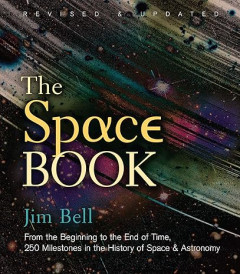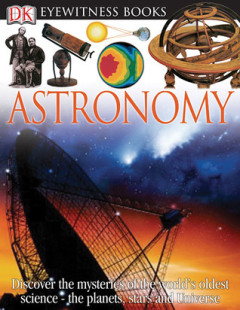Ditapis dengan
E-book Big Ideas in Astronomy : A Proposed Definition of Astronomy Literacy
This is the motto of the International Astronomical Union (IAU) Office for Astronomy Outreach. If “All” is a very vast term to define society and its communities, “Astronomy” as a body of knowledge is also similarly vast. This project, “Big Ideas in Astronomy”, explores the issue: “What should science-educated citizens know about astronomy?” As a result of several discussion…
- Edisi
- -
- ISBN/ISSN
- 9789491760211
- Deskripsi Fisik
- 68 hlm
- Judul Seri
- -
- No. Panggil
- 520 RET b

E-book The Space Book Revised and Updated: From the Beginning to the End of T…
Since the original edition of The Space Book was published in 2013, much has happened in the world of space exploration. This revised and updated edition, with a new introduction from author Jim Bell, brings the popular Milestones book up to date. It includes the most exciting and newsworthy breakthroughs, from the groundbreaking discovery of the Trappist-1 system to the technologies of the fut…
- Edisi
- -
- ISBN/ISSN
- 9781454935582
- Deskripsi Fisik
- 797 halaman, ilus.
- Judul Seri
- -
- No. Panggil
- 520 BEL t
E-book Astronomy and Astrophysics in the New Millenium
In this new book, a distinguished panel makes recommendations for the nation's programs in astronomy and astrophysics, including a number of new initiatives for observing the universe. With the goal of optimum value, the recommendations address the role of federal research agencies, allocation of funding, training for scientists, competition and collaboration among space facilities, and much mo…
- Edisi
- -
- ISBN/ISSN
- 0309070376
- Deskripsi Fisik
- 401 halaman
- Judul Seri
- -
- No. Panggil
- 520 AST a

E-book Eyewitness: Astronomy
Looks at the history of astronomy, identifies important astronomers, and summarizes what is known about the Sun, Moon, planets, and stars.
- Edisi
- -
- ISBN/ISSN
- 9780756637675
- Deskripsi Fisik
- 76 halaman, ilus.
- Judul Seri
- -
- No. Panggil
- 520 LIP e
E-book A Researcher’s Guide to: Cellular Biology
The International Space Station offers a valuable platform and environment for cell biology investigations, novel discoveries and innovation in a microgravity environment. Areas of opportunity include tissue culture studies, tissue engineering research using 3-D tissue models, biopharmaceutical production, host microbe interactions, host-toxicology interactions, and host-drug sensitivity and re…
- Edisi
- -
- ISBN/ISSN
- -
- Deskripsi Fisik
- 50 halaman, ilus.
- Judul Seri
- -
- No. Panggil
- 520 NAS a
E-book A Researcher’s Guide to: Fruit Fly Research
For decades, researchers have used the fruit fly Drosophila to probe the combined effects of microgravity and other conditions of spaceflight with exposure to ionizing radiation. Drosophila melanogaster provides a well-characterized model organism that is both genetically complex and relatively modest in its habitat and life support requirements. Microgravity exposure, a unique biological chall…
- Edisi
- -
- ISBN/ISSN
- -
- Deskripsi Fisik
- 48 halaman, ilus.
- Judul Seri
- -
- No. Panggil
- 520 NAS a
E-book CAP Journal Issues 34 Special Edition II Celebrating 100 Years of the …
- Edisi
- -
- ISBN/ISSN
- -
- Deskripsi Fisik
- 44 halaman, ilus.
- Judul Seri
- -
- No. Panggil
- 520 IAU c
- Edisi
- -
- ISBN/ISSN
- -
- Deskripsi Fisik
- 44 halaman, ilus.
- Judul Seri
- -
- No. Panggil
- 520 IAU c
E-book Astronomy: A history of Man's Investigation of the Universe
Hoyle begins his story with accomplishments of the astronomers of the ancient world - the Babylonians, Mesopotamians, Egyptians, Greeks, and Romans - amd their attempts to measure distance between heavenly bodies and to find order in the bewilding motions of the planets. Hoyle then recreates the richly varied lives and works of Copernicus, Kepler, Brache, and Galileo, showing hoe their work set…
- Edisi
- -
- ISBN/ISSN
- -
- Deskripsi Fisik
- 328 halaman, ilus.
- Judul Seri
- -
- No. Panggil
- 520 HOY a
E-Book Astronomy Hours
- Edisi
- -
- ISBN/ISSN
- -
- Deskripsi Fisik
- 23 halaman. ilus.
- Judul Seri
- -
- No. Panggil
- 520 AFI a
- Edisi
- -
- ISBN/ISSN
- -
- Deskripsi Fisik
- 23 halaman. ilus.
- Judul Seri
- -
- No. Panggil
- 520 AFI a
E-Book CAP Journal Issues 33: Special Edition Celebrating 100 Years of The Pl…
- Edisi
- -
- ISBN/ISSN
- -
- Deskripsi Fisik
- 64 halaman, ilus.
- Judul Seri
- -
- No. Panggil
- 520 IAU c
- Edisi
- -
- ISBN/ISSN
- -
- Deskripsi Fisik
- 64 halaman, ilus.
- Judul Seri
- -
- No. Panggil
- 520 IAU c
E-Book CAP JOURNAL ISSUE 26: Spotlighting A Black Hole
- Edisi
- -
- ISBN/ISSN
- -
- Deskripsi Fisik
- 37 halaman
- Judul Seri
- -
- No. Panggil
- 520 CAP
- Edisi
- -
- ISBN/ISSN
- -
- Deskripsi Fisik
- 37 halaman
- Judul Seri
- -
- No. Panggil
- 520 CAP
E-book Handbook of Space Astronomy and Astrophysics
This ebook contains space Astronomy and Astrophysics.
- Edisi
- -
- ISBN/ISSN
- 9780511348723
- Deskripsi Fisik
- 781 hlm
- Judul Seri
- -
- No. Panggil
- 520 ZOM h
 Karya Umum
Karya Umum  Filsafat
Filsafat  Agama
Agama  Ilmu-ilmu Sosial
Ilmu-ilmu Sosial  Bahasa
Bahasa  Ilmu-ilmu Murni
Ilmu-ilmu Murni  Ilmu-ilmu Terapan
Ilmu-ilmu Terapan  Kesenian, Hiburan, dan Olahraga
Kesenian, Hiburan, dan Olahraga  Kesusastraan
Kesusastraan  Geografi dan Sejarah
Geografi dan Sejarah